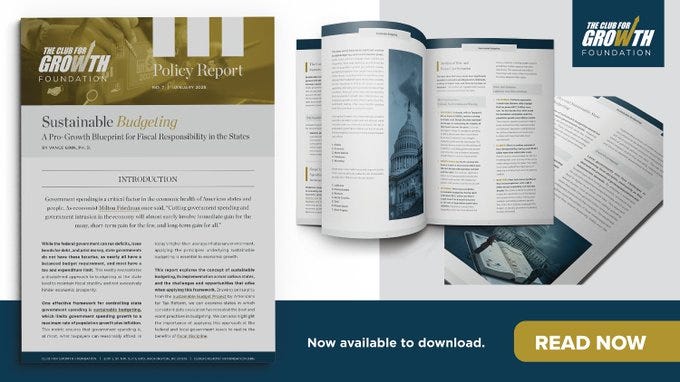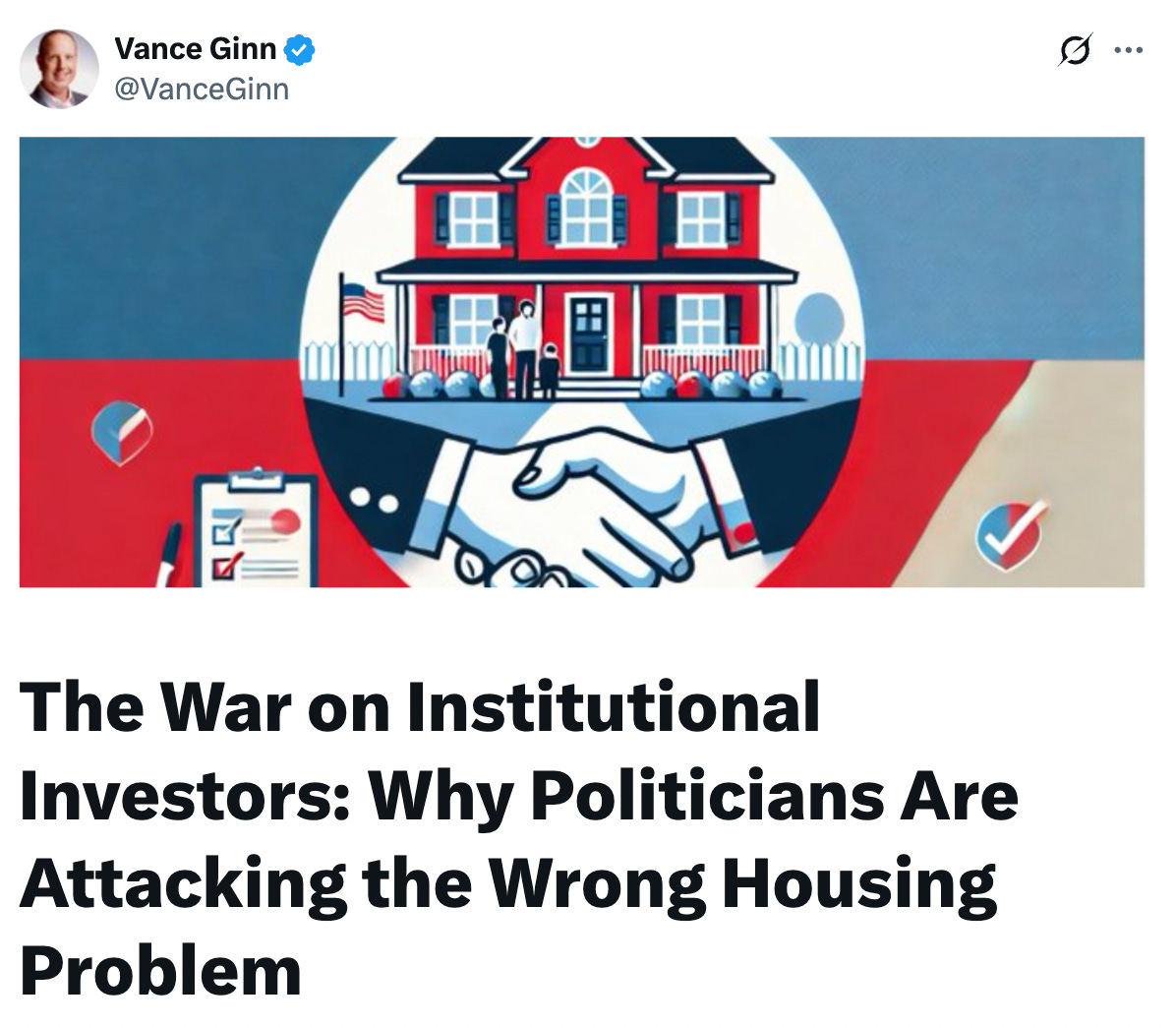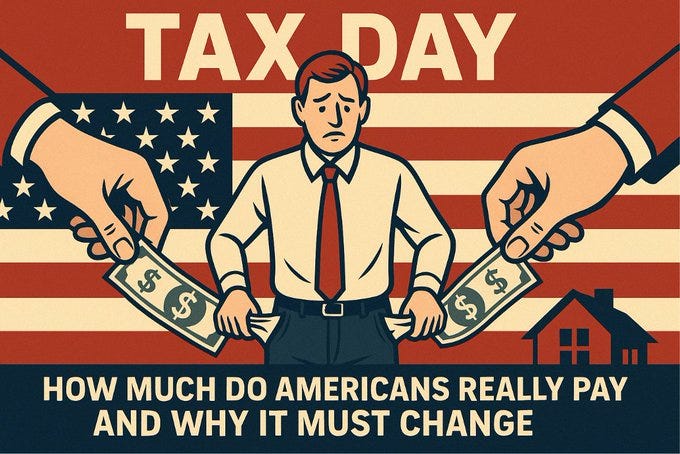Why is Housing So Expensive? | This Week's Economy Ep. 108
Explore the causes and solutions to our nation's housing affordability crisis.
Hello Friends!
For many American families, homeownership—a cornerstone of the American Dream—is slipping further out of reach. Housing prices continue to rise, and even renting has become more expensive, leaving families feeling squeezed on all sides.
There are signs of hope. Several states are taking action this legislative cycle, exploring ways to reduce or eliminate property taxes. But more can and should be done—at both the state and federal levels—to make homeownership more affordable. Smart policy reforms won’t just benefit buyers; they’ll also help lower rental costs, easing the pressure on families across the board.
That’s precisely what we’re diving into in today’s episode of This Week’s Economy. I’ll break down how we got here—and what policies we can champion to make housing more affordable for everyone.
Catch the full episode on YouTube, Apple Podcast, or Spotify, and visit my website for more information.
HOW WE GOT HERE
The Background:
The Past: Under the first Trump administration, pro-growth policies like the Tax Cuts and Jobs Act, deregulation, and private-sector-driven development helped boost the economy and expand housing opportunities. These reforms reduced barriers and encouraged new construction. But the pandemic—and the Biden administration’s response—reversed that progress. Lockdowns and supply chain disruptions stalled projects, while massive spending and regulatory expansion drove inflation, raising the cost of materials and pushing housing prices even higher.
The Present: Today, high interest rates, labor shortages, and elevated material costs are making homes less affordable for working families. However, the solution isn't more government spending or regulation—it’s a return to policies that allow builders to build. Lower taxes, faster permitting, zoning reform, and access to skilled labor are essential to increasing housing supply and reducing costs.
The Future: To achieve more affordable housing and expand homeownership, we need policies that remove barriers and empower the private sector. With the Trump administration, a Republican-led Congress, and state-level leadership committed to reform, we can restore affordability and give more Americans the chance to own a home.
Keep reading for my policy solutions.
1. REDUCE GOVERNMENT SPENDING

The Principles:
With the national debt now surpassing $36 trillion, runaway government spending has become a crisis. Many states are following suit, pushing budgets to unsustainable levels and putting long-term fiscal health at risk. Fiscal restraint is essential to preserving competitiveness and economic stability.
My Solutions:
Rein in Federal Spending: Deficits have ballooned to $2 trillion annually under both the Trump and Biden administrations, pushing the national debt to 125% of GDP. Reckless, bipartisan spending has fueled inflation and created uncertainty for families and businesses. We must reduce spending and adopt pro-growth policies to restore fiscal balance.
Enforce Spending Limits: Implementing a strict spending limit that ties government spending growth to the maximum rate of population growth plus inflation, as used in Colorado’s Taxpayer’s Bill of Rights (TABOR), ensures government lives within taxpayers' means and can be adopted at the state and federal levels.
Eliminate Waste: The Department of Government Efficiency (DOGE) focuses on cutting federal waste, reducing redundancy, and streamlining government operations using private-sector principles. Several states are already adopting their versions of DOGE.
Related Resources: Controlling the budget starts with sustainable spending. Explore the Sustainable Budgeting Project at Americans for Tax Reform and my budgeting guide at Club for Growth Foundation.
2. DEREGULATE THE ECONOMY

The Principles:
Excessive regulation and outdated zoning laws are key drivers of the housing affordability crisis. Restrictive zoning limits where and what types of homes can be built, constraining supply and increasing prices. Reforming these policies would increase housing availability, boost competition, and reduce costs for buyers and renters. Beyond zoning, burdensome regulations—especially in construction—raise building costs and slow development.
My Solutions:
Regulatory Costs: Under Biden, final regulatory costs surged by at least $1.8 trillion—an invisible tax that raises prices, stifles innovation, and delays growth. The second Trump administration must prioritize reducing bureaucratic red tape, especially in industries such as housing and infrastructure.
Faster Permitting: Streamlining the permitting process for infrastructure and energy projects will accelerate construction timelines, reduce material delays, and support nationwide growth in housing and development.
Zoning Reform: State and local governments should pursue zoning reforms to unlock more housing construction. Loosening restrictions will help meet demand and make homeownership more accessible to families.
Related Resource: I recently challenged on X the misguided regulations targeting the wrong causes of the housing crisis—and offered more innovative alternatives.
3. CUT TAXES & ENCOURAGE GROWTH

The Principle:
Property taxes are fundamentally unfair—they force homeowners to continually “rent” their property from the government. True homeownership should mean owning your home without a lifelong tax burden. More broadly, tax cuts fuel economic growth and let hardworking families keep more of what they earn—especially when trying to afford better housing.
My Solutions:
Extend the Trump Tax Cuts: Key provisions of the Tax Cuts and Jobs Act—including lower individual tax rates and a higher standard deduction—are set to expire at the end of 2025. The Trump administration should prioritize extending and strengthening these reforms to maintain relief for American families.
Lower Corporate Taxes: The U.S. still faces a competitive disadvantage with a combined average federal and state corporate tax rate of 25%, higher than the developed world average and even China’s. To make America a global leader in innovation, we should reduce the rate to at least 15%, with a long-term goal of eliminating it. Businesses don’t pay taxes—people do.
Promote Investment: Policies should encourage investment to drive economic expansion, spark innovation, and create jobs throughout the economy. Some examples are lowering marginal rates, simplifying tax brackets, permanently allowing full expensing of capital investments, and indexing capital gains to inflation to stop taxing phantom gains.
Related: My latest piece on X discusses how extending the 2017 Tax Cuts and Jobs Act offers a rare moment of relief for American families.
4. INFRASTRUCTURE NEEDS

The Principle:
Robust trade, energy, and infrastructure sectors are essential to a strong construction industry, which in turn helps expand the housing supply and reduce costs. To support these foundational industries, policymakers should prioritize pro-growth, free-market policies that allow businesses to thrive.
My Solutions:
Energy Independence: A strong economy relies on domestic energy production, and the construction industry plays a vital role in that effort. The Trump administration’s focus on rolling back burdensome regulations from the Biden era can reduce costs, boost job creation, and enhance national security.
Free Trade: Tariffs on key construction materials like steel, aluminum, and concrete raise costs for builders and families. Eliminating these tariffs and modernizing trade agreements will lower input costs, enhance competitiveness, and foster infrastructure development.
Public-Private Partnerships (P3s): As demand grows for roads, housing, and energy, P3s offer a smart path forward. By leveraging private-sector innovation and investment, states can deliver high-quality infrastructure more efficiently while minimizing taxpayer risk.
Related Resources: Read my speech to the Texas Aggregates and Concrete Association on How Policy Uncertainty Drives Economic Volatility in an Election Year.
5. WORKFORCE DEVELOPMENT

The Principle:
The construction industry is facing severe labor shortages, which are driving up wages and delaying projects. We need a stronger, more reliable workforce to meet demand and keep costs reasonable.
My Solutions:
Workforce Development: Many companies cite a lack of qualified workers as a barrier to growth. States should adopt Utah’s successful “One Door” approach, which integrates workforce training with social services to help individuals—especially those in poverty—enter and stay in the workforce.
Expand Technical Education: Boosting access to technical schools and apprenticeships will equip workers with the skills industries need, without overburdening taxpayers or pushing everyone toward a traditional college path.
Grow the Labor Force: Smart immigration reforms can help fill critical labor gaps, especially in difficult—to—staff roles. These reforms will support industries like construction while ensuring the economy continues to grow.
Related Resource: I discuss smarter immigration policies to help grow the workforce in this clip from an episode of Let People Prosper.
Freedom is the foundation of our economy and must remain so. The construction industry demonstrates this daily, building the infrastructure that drives America. Imagine what could be achieved with streamlined permitting, lower taxes to fuel innovation, and fiscal discipline to stabilize the economy.
For more details, please refer to my comprehensive guide here.
Thanks for joining me in this episode of "This Week's Economy." For more insights, visit vanceginn.com and get even greater value with a paid subscription to my Substack newsletter at vanceginn.substack.com.
God bless you, and let people prosper!
Keep reading with a 7-day free trial
Subscribe to Let People Prosper to keep reading this post and get 7 days of free access to the full post archives.









